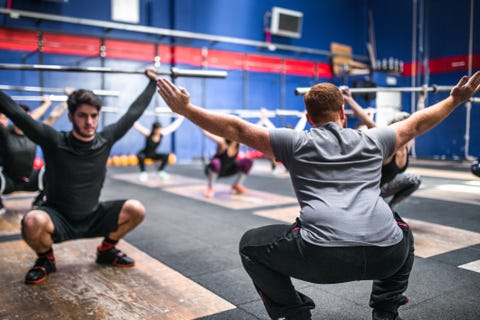What to Do When You Get Conflicting Fitness Advice
Google around for tips on how to get in shape, and you’ll come across thousands of videos, articles, posts, and tweets—and most of them will be offering out completely different advice.
There’s conflicting information coming at you from all directions, and you can’t figure out who, or what, to believe. So you end up dabbling in this and that, hopping from one thing to the next, never really taking consistent action on anything. Meanwhile, your gains are nonexistent, your goals feel unreachable, and you’re mortified that all of your effort has just been a massive waste of time and effort.
If you feel like you’re drowning in a sea of information and you don’t know what to do, here are three simple steps you can take to separate fitness fact from fiction. Future-proof yourself against BS, fight back against fitness information overload, and put yourself on the right track for a fitter, healthier you.
Find Your Own Best Way
Back when I started lifting weights, it seemed like no one could ever agree on the type of training program that worked best for muscle growth. Everyone seemed to have a completely different opinion, and all were adamant that their way was the best way.
Surely they couldn’t all be right. Or could they?
In fact, research shows that some folks respond a lot better to certain diets and training programs than others. A study published in the Journal of Strength and Conditioning Research shows that roughly three out of 10 subjects saw faster muscle growth when they trained a muscle five times per week. Another four out of 10 got faster results when they trained that same muscle two or three times a week. The others made similar gains irrespective of how often each muscle was trained.
It’s a similar story when it comes to diet. In a 2018 study, Australian researchers looked at how three months of low-carb dieting affected lifting performance in a group of competitive strength athletes.
Whether the lifters followed a ketogenic or a regular diet, the average gains in strength were virtually identical. However, the problem with looking at averages is that they can mask individual changes in performance. A closer look at the results shows that different people responded in different ways to the same diet.
Three of the 10 subjects made better strength gains on the ketogenic diet. One saw exactly the same results no matter which diet they followed. The other six saw their gains take a dip when they cut back on carbs.
In other words, individuals can respond very differently to the same diet and training program. That’s one of the reasons why there’s so much conflicting advice about how to get in shape. The “best way” for one person to train and eat may be very different to someone else’s “best way,”—and you’re only going to discover what works for you is through experience.
Be Skeptical of Novelty

Getty ImagesWestend61
Put a rat in a maze, and it will automatically explore a newly opened section of the maze. That’s because most mammals have a strong preference for novelty—and humans are no different.
“The brain is built to ignore the old and focus on the new,” Dr. Russell Poldrack, a professor of psychology and researcher at Stanford, wrote in 2011. “Novelty is probably one of the most powerful signals to determine what we pay attention to in the world. This makes a lot of sense from an evolutionary standpoint, since we don’t want to spend all of our time and energy noticing the many things around us that don’t change from day to day.”
Novelty makes you happy. Fresh experiences of any kind tend to trigger the release of chemicals in the brain that make us feel good. However, novelty also has a darker side. It’s easy to become “hooked” to the chemical high associated with novelty, especially when that rush is so easily accessible through a phone, tablet or computer.
Reading about so-called “new and revolutionary” ways to get in shape can feel good. And, some of them can (occasionally) come in handy. But the constant hunt for novelty can easily backfire, sending you off in completely the wrong direction.
In the fitness industry, new ideas are often considered superior to those that came before. Not because they are actually better, but simply because they’re new. Originality seems to take precedence over effectiveness. Old solutions are sometimes perceived to be less valuable because we already know about them.
Truth is, much of what passes for “new and revolutionary” in the nutrition and exercise arena is either not new at all, or extremely controversial and highly speculative. Exposed to the scrutiny of research, some of it will inevitably turn out to be wrong.
You don’t necessarily need anything new or unique to get in better shape than you are now (outside of the methods being new to you, of course). That’s because tried-and-true methods will often do the job just as well. There’s really nothing new under the sun, as the old saying goes, just the history you don’t know yet. That applies to fitness, too, to a degree.
“Progress often hides behind boring solutions and underused insights,” writes Atomic Habits author James Clear. “You don’t need more information. You don’t need a better strategy. You just need to do more of what already works.”
Focus on Relentless Execution of the Fundamentals

Getty Imagesfranckreporter
When people look for a new diet and exercise program to follow, they tend to search for the “best workout” for this or the “best diet” for that, which is itself not a problem. Why waste time doing something that takes longer and is less effective than what you could be doing?
The problem lies in what happens next:
Choice, in general, is a good thing. You want to make sure that every decision is the best decision that could possibly be made, and the only way to do that is to check out all the alternatives.
Even after you’ve done that, however, there might still be nagging doubts in your mind that there something better is out there that you didn’t investigate properly. Eventually, “choice overload” kicks in, where the sheer number of options, combined with the fear of making the “wrong” choice, leaves you unable to make a decision about what to do next.
Instead, take a tip from billionaire Warren Buffett, one of the most successful investors of all time. “An investor needs to do very few things right,” says Buffet, “as long as he or she avoids big mistakes.”
It’s much the same story when it comes to diet and exercise. If you want to build a better body, you need to do a few simple things right, do them consistently, and avoid big mistakes. Multiple paths can lead to the same destination, and it’s the consistent and relentless execution of the fundamentals that will get you where you want to go.
Source: Read Full Article


